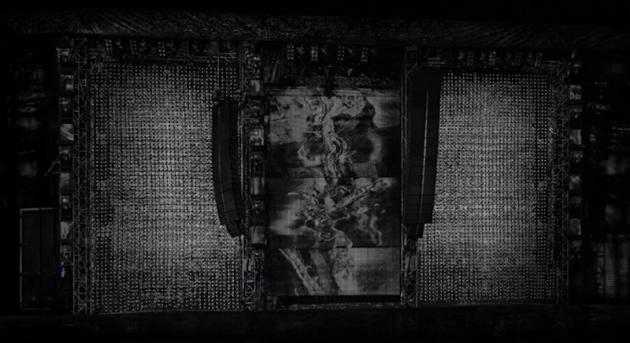White Cube Bermondsey and Sprüth Magers London are presenting major new exhibitions of the photographer Andreas Gursky. White Cube’s exhibition is his first in London since 2007 and his second with the gallery. Gursky’s photographs frequently depict the landscape and structures of late capitalism; its sites of industry, leisure and consumption with sharp and critical acuity. In this exhibition, which includes both new and earlier work, Gursky addresses aspects of both high and low visual culture, exploring the themes of image manufacture and exchange, as well as ideas of authenticity, ownership and control in our increasingly digitised age.
The exhibition centres around a striking new series of photographs that appropriate images taken from Hollywood ‘superhero’ feature films. These ‘superhero’ works from 2013-2014, depict scenes from the Ironman III, Batman and Spiderman films respectively, portraying instantly recognisable comic characters amid idealised, isolated landscapes. The works evoke a sense of alienation, asserting both the power of fantasy and pervasiveness of pop cultural imagery and its immersive presence in the communal psyche.
The museum as a site of consumption and arbiter of market forces is the subject of the works Lehmbruck I (2013) and Lehmbruck II (2014). These two new works present the distinctive glass and concrete architecture of the Lehmbruck Museum in Duisburg, adjusted to appear more like a stage set, with a selection of iconic works of art and an audience of one or two carefully placed figures. The interiors have been shot from a characteristically elevated vantage point, which serves to emphasise the hieratic nature of museum architecture.
From the moment he started making photographs to the present day, the landscape has captivated Andreas Gursky. The Spruth Magers exhibition is the first to focus on a group of important early landscapes from the late 1980s to the early 1990s. Predating Gursky’s extensive use of digital technology, and characterised by what the artist has called an ‘extraterrestrial’ perspective, the pictures are titled simply and directly after the geographical location where they were taken.
In Niagara Falls (1989), a boatload of tourists, draped in black rain gear, appears to be heading directly into a section of the falls where the white crashing water has obliterated any legible detail. If this photograph depicts a sublime landscape, Mettmann, Autobahn (1993) shows instead a calm, bucolic scene intersected by silver-grey bars. At first glance, the bars look like they were inserted into the photograph by the artist as an extreme formal gesture, but they were already at the site, integral to a Plexiglass screen that acted as a noise barrier along the motorway. Gursky noticed this interweaving of classic pastoral and utilitarian technology while driving. In Alba (1989) the landscape is similarly ageless: a river, barely a ripple in its surface and framed by a dark forest, trickles over a stony riverbed as it has for centuries. Fishermen, dwarfed by the artist’s sweeping view of the site, wade into the water.
Gursky’s early landscapes at Sprüth Magers Grafton St. gallery, provide the viewer with the concrete experience of a specific place as well as what Martin Hentschel has called a ‘mental image … that has been passed down to us by the history of painting and inscribed into our collective memory’. The pictures conjure both a topography and a structure: Niagara Falls might be an overexposed tourist destination, but Gursky discovers a peculiar mood there. A boat transports its human freight, entranced by a white abyss, to an uncertain fate. Yet we know that these tourists won’t get swamped by the falls, however precarious they look in the picture. Moreover, the overall calm and balance of the composition has the power to counteract any overwhelming sense of threat. Likewise, even while Alba taps into our deepest sense of what a landscape might express, from ancient idylls to Caspar David Friedrich, the photograph also depicts a mundane evening in Italy. The landscape is at once itself, a specific time and place, and also something otherworldly: a picture that transcends the basic conditions of its creation.
Andreas Gursky (born 1955, Leipzig, Germany) lives and works in Düsseldorf. He was appointed Professor of Liberal Arts at the Kunstakademie Dusseldorf in 2010. Solo exhibitions include the current exhibition at The National Museum of Art, Osaka (2014) and recent exhibitions at The National Art Center, Tokyo (2013), Stiftung Museum Kunstpalast, Dusseldorf (2013) and Louisiana Museum of Modern Art (2012). A solo exhibition organized by the Museum of Modern Art, New York toured to Centro de Arte Reina Sofia, Madrid, Centre Georges Pompidou, Paris, MCA Chicago and SF MOMA, San Francisco (2001). His first retrospective “Retrospektive 1984-2007” was shown at Haus der Kunst in Munich and toured Istanbul Modern to Sharjah Art Museum (2007) and from Ekaterina Foundation, Moscow to National Gallery of Victoria, Melbourne (2008). Another exhibition ‘Andreas Gursky: Werke 1980 – 2008’ at the Museum Haus Esters Haus Lange, Krefeld (2008) travelled to Moderna Museet, Stockholm and at the Vancouver Art Gallery (2009).
Andreas Gursky South Galleries White Cube Bermondsey 30 April – 6 July 2014
Andreas Gursky. Early Landscapes Sprüth Magers, London, April 15 – june 21 2014

